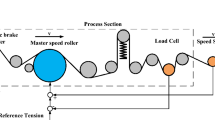Abstract
Winding is an integral operation in almost every roll to roll system. A center-wound roll is one of the suitable and general schemes in a winding mechanism. In general, the quality of wound roll is known to be related to the lateral displacement error and starring defect of a wound roll. Especially, a telescoping within a center-wound roll can cause damages such as misalignment between layers, folding, wrinkle, etc. Taper tension is known to be one of the major factors which affect the shape of a wound roll. It is therefore necessary to analyze the relationship between taper tension profile and telescoping within the center-wound roll to prevent winding failure and to sustain high quality of the printed materials. It is hard to compensate for undesirable winding roll shapes such as telescoping, because a winding is commonly a final process in roll to roll systems and has no feedback control mechanism to correct winding roll shape directly during winding operation. Therefore, an optimal taper tension profile and the accurate control of it in a winding section could be one way to shape the fail-safe of a wound roll. Through the correlation between taper tension profile and telescoping in a winding process, a mathematical model for the telescoping due to tension distribution in cross machine direction was developed, and verified by experimental study. A new logic to determine the proper taper tension profile was designed by combining and analyzing the winding mechanism which includes nip induced tension model, relationship between taper tension profile and telescoping, relationship between taper value and telescoping. Numerical simulations and experimental results show that the proposed method is very useful for determining the desirable taper tension profile during the winding process and preventing defects of winding roll shape such as telescoping.
Similar content being viewed by others
References
S. J. Burns, Richard, R. Meehan and J. C. Lambropoulos, Strain-based Formulas for Stresses in Profiled Center-Wound Rolls, Tappi journal, 82 (1999) 159–167.
J. K. Good, J. D. Pfeiffer and R. M. Giachetto, Losses in Wound-On-Tension in the Center Winding of Wound Rolls, Proceedings of the Web Handling Symposium, ASME Applied Mechanics Division, 149 (1992) 1–12.
C. W. Lee, J. W. Lee, K. H, Shin and S. O. Kwon, A taper tension profile maker in a converting machine, Journal of Mechanical Science and Technology, 22 (2008) 77–84.
C. W. Lee, J. W. Lee and K. H, Shin, A study on the optimal taper tension control in a roll to roll machine, The International Conference on Computational Science and Its Applications, Part2 (2007) 919–930.
D. R. Roisum, Runnability of Paper Par2: Troubleshooting Web Breaks, Tappi Journal, 73 (1990) 101–106.
D. R. Roisum, Winder Vibration Can Reduce Operating Efficiency, Tappi Journal, 71 (1988) 87–96.
Z. Hakiel, Nonlinear model for wound roll stresses, Tappi journal, 70 (1987) 113–117.
C. Heinz and Altmann, Formulas for Computing the Stresses in Center-Wound Rolls, Tappi journal, 51 (1968) 176–179.
H. P. Yagoda, Resolution of a Core Problem in Wound Rolls, Journal of Applied Mechanics, 47 (1980) 847–854.
J. Shelton, Lateral Dynamics of a Moving Web, Ph. D. dissertation Oklahoma state Univ. Stillwater, (1968).
J. Shelton and K. N. Reid, Lateral Dynamics of a Real Moving Web, ASME Journal Dynamics, Syst., Measurement, Control, 93 (1971) 180–186.
J. Shelton, The Effect of Camber on Handling, Proceedings of the International Conference on Web Handling, Oklahoma state Univ. Stillwater, (1997) 248–263.
K. H. Shin and S. O. Kwon, The Effect of Tension on the Lateral Dynamics and Control of a Moving Web, IEEE Trans. on Industry Applications, 43 (2007) 403–412.
K. S. Ducotey and J. K. Good, The Effect of Web Permeability and Side Leakage on the Air Film Height Between a Roller and Web, ASME Journal of Tribology, 120 (1998) 559–565.
K. S. Ducotey and J. K. Good, Predicting Traction in Web Handling, ASME Journal of Tribology, 121 (1999) 618–624.
K. S. Ducotey and J. K. Good, A Numerical Algorithm for Determining the Traction Between a Web and a Circumferentially Grooved Roller, ASME Journal of Tribology, 122 (2000) 578–584.
Author information
Authors and Affiliations
Corresponding author
Additional information
This paper was recommended for publication in revised form by Associate Editor Kyung-Soo Kim
Changwoo Lee (S’01-M’03) received a B.S. degree in Mechanical Engineering from Konkuk University in 2001. He received his M.S. and Ph.D. degrees from Konkuk university in 2003 and 2008, respectively. He is currently a research professor at the Flexible Display Roll to Roll Research Center at Konkuk University in Seoul, Korea, where he is working on the development of R2R multi-layer printing systems for printed electronics. His research interests are in the area of fault tolerant control, R2R e-Printing line design, non-contact transporting process, and tension-register control. He is the holder of several patents related to R2R e-Printing system.
Keehyun Shin (S’81-M’87) received the B.S. degree from Seoul National University, Seoul, Korea, and the M.S. and Ph.D. degrees in mechanical engineering from Oklahoma State University (OSU), Stillwater. Since 1992, he has been a Professor with the Department of Mechanical Engineering, Konkuk University, Seoul, Korea and director of Flexible Display Roll to Roll Research Center. For more than 18 years, he has covered several research topics in the area of web handling, including tension control, lateral dynamics, diagnosis of defect rolls/rollers, and fault-tolerant real-time He is the author of Tension Control (Atlanta, GA: TAPPI Press, 2000) and is the holder of several patents related to R2R e-Printing systems.
Rights and permissions
About this article
Cite this article
Lee, C., Kang, H., Kim, H. et al. Effect of taper tension profile on the telescoping in a winding process of high speed roll to roll printing systems. J Mech Sci Technol 23, 3036–3048 (2009). https://doi.org/10.1007/s12206-009-0906-2
Received:
Revised:
Accepted:
Published:
Issue Date:
DOI: https://doi.org/10.1007/s12206-009-0906-2




